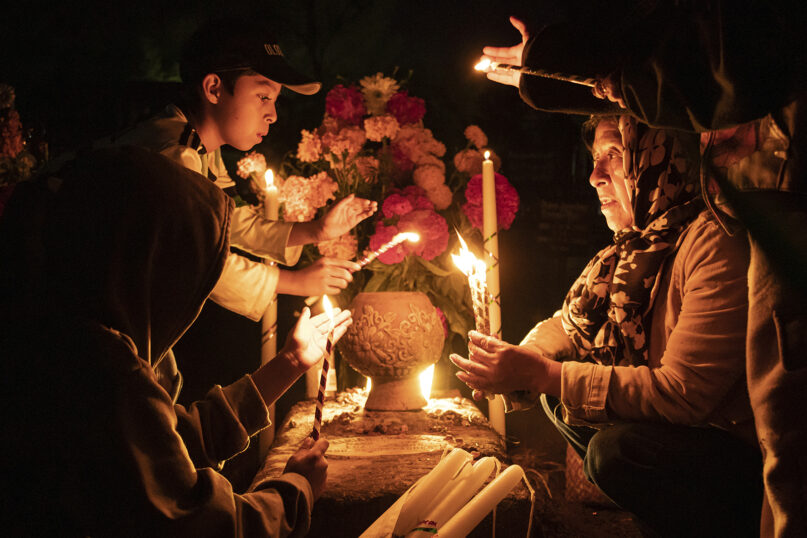This All Souls’ Day, experience moments of connection with those who have gone before us
This is an intentional act of cultivating relationship with our ancestors.

(AP Photo/Maria Alferez)
(RNS) — In Celtic tradition there are many moments considered to be a “thin time,” which means that heaven and earth feel closer and we might experience moments of connection to those who have gone before us in ways that we don’t usually.
These moments include the daily portals of dawn and dusk as the world moves from dark to light and back to dark again. They also include the eight threshold moments of the year, which are the solstices, the equinoxes and the cross-quarter days that fall between the solstices and equinoxes. Of these eight, Samhain, which falls on Nov. 1, is considered to be the thinnest time, when the ancestors and spirits walk among us. The door between the spiritual and the physical is even further open than at other times.
Samhain is the start of the dark half of the year. It is the season of rest, incubation and mystery. It is the season of dreamtime and the perfect time of year to open your heart to connect with those who journeyed before you. Winter invites us to gather inside, grow still with the landscape and listen for the voices we may not hear during other times of the year. These may be the sounds of our own inner wisdom or the voices of those who came before us.
Listen for the messages of the ancestors in those days especially — they will speak their wisdom through raven and stone, tree and rain, dreams and synchronicities. This is the language through which we receive these gifts and only need to open ourselves to them.
The Celtic feast of Samhain coincides with the Christian celebration of All Saints’ Day on Nov. 1 and All Souls’ Day on Nov. 2, which begin a whole month in honor of those who have died. We tend to neglect our ancestral heritage in our Western culture, but in other cultures, remembering the ancestors is an intuitive and essential way of beginning anything new. We don’t recognize the tremendous wisdom we can draw on from those who have traveled the journey before us and whose DNA we carry in every fiber of our bodies.
Ritual has a way of bridging the gap between the visible and invisible worlds and between the conscious and unconscious knowing. We can open ourselves to communication from our grandmothers and grandfathers. What we work on consciously through ritual and prayer has an impact in the world of the ancestors. Ritual is the intentional cultivation of relationship, but communication happens in spontaneous ways as well.
In Christian ritual and liturgy, there is the celebration on the Feasts of All Saints and All Souls. Some churches keep a Book of the Dead, in which the names of loved ones who died are written and kept near the altar so they may be remembered at Masses throughout November.
November is the month of the dead, and churches often have special Masses of remembrance throughout the month as well as setting up a special ancestral altar somewhere in the church space where members can bring photos, flowers and other offerings. Many churches also have votive candles available all year, which people can light either as a prayer for themselves or another or in remembrance of a loved one.
In medieval Europe, there were many practices for All Souls’ Day, including creating altars, celebrating requiem Masses, lighting candles and bonfires, visiting graves, ringing bells and making soul cakes, which were small, round, spiced loaves to commemorate the dead that were given out to people who came door to door.
We communicate with ancestors much in the way we would communicate with angels and saints — through dreams, visions, synchronicity, nature, ritual and imagination. We call upon them through prayer, we honor them through ritual offerings, and we ask them for guidance.
Henri Nouwen offers us this wisdom: As we grow older we have more and more people to remember, people who have died before us. It is very important to remember those who have loved us and those we have loved. Remembering them means letting their spirits inspire us in our daily lives. They can become part of our spiritual communities and gently help us as we make decisions on our journeys. Parents, spouses, children and friends can become true spiritual companions after they have died. Sometimes they can become even more intimate to us after death than when they were with us in life. Remembering the dead is choosing their ongoing companionship.
I especially love that final sentence: “Remembering the dead is choosing their ongoing companionship.” This is an intentional act of cultivating relationship.
The first fundamental blessing we can offer gratitude for is the gift of life itself. No matter what kind of family we came from, no matter how much suffering was caused, there is the fundamental impulse toward life that we can celebrate. We can give thanks for being here, being fully alive and even having the privilege of taking time to do this healing work: to explore spiritual practices and to ponder what makes our lives meaningful. Many of our ancestors never had that luxury.
Many worked very long hours for little reward and were never able to pause and ask themselves how their own generational connection could bring more wisdom to their lives.
I like to remember as well that in the midst of my ancestors’ struggles there was at least some resilience and courage developed that I have inherited. This is the second fundamental blessing we can offer gratitude for. I may never know what they went through exactly, but I can sometimes feel their sturdiness and how they endured. They too lived through times of war and plague and economic struggle.
Sometimes when I go outside at night and can see the brilliance of the stars, I remember that my ancestors also had moments of wonder and awe standing with their faces upturned toward the vast expanse of the universe. I remember that they too had moments of delight, of joy, of dancing, no matter how hard their lives were.
(Christine Valters Paintner is the author of “The Love of Thousands: How Angels, Saints, and Ancestors Walk With Us Toward Holiness” (Sorin Books), from which this column is adapted with permission. She is the online abbess for Abbey of the Arts, a virtual monastery offering classes and resources on contemplative practice and creative expression. The views expressed in this commentary do not necessarily reflect those of Religion News Service.)

No comments:
Post a Comment